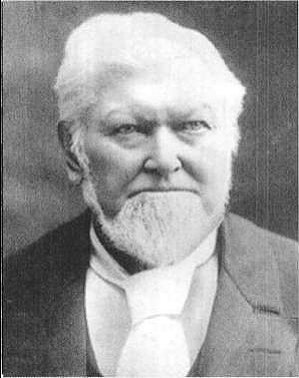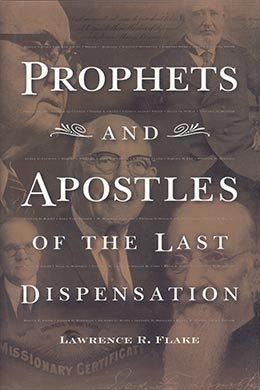Wilford Woodruff
Lawrence R. Flake, Prophets and Apostles of the Last Dispensation (Provo, UT: Religious Studies Center, Brigham Young University, 2001), 43–48.

Born: 1 March 1807, Avon (Farmington), Connecticut
Quorum of the Twelve Apostles: 26 April 1839 (age 32)
President of the Quorum of the Twelve: 10 October 1880
President of the Church: 7 April 1889 (age 82)
Died: 2 September 1898 (age 91), San Francisco, California
When the venerable President Wilford Woodruff entered the Salt Lake Tabernacle 1 March 1897, he was greeted by the largest crowd ever assembled in that building. The congregation was made up mostly of children gathered to honor him on his ninetieth birthday. The building was beautifully decorated and was draped with large banners bearing the words “Glory to God,” “Honor to His Prophet,” “We honor the man honored by God,” and “1807–1847–1897.” [1]
When the children arose and sang “We Thank Thee, O God, for a Prophet,” President Woodruff was overcome with emotion. Later he wrote, “The scene completely overpowered me. The events of my childhood and early manhood came to my mind. I remembered vividly how I prayed to the Lord that
I might live to see a prophet or an apostle who would teach me the gospel of Christ. Here I stood in the great Tabernacle filled with ten thousand children, with Prophets, Apostles, and Saints. My head was a fountain of tears.” [2]
As a boy in Connecticut, Wilford had made friends with an old gentleman by the name of Robert Mason. This great and spiritual man possessed the gift of prophecy, and among the truths revealed to him was the fact that the kingdom of God would soon be reestablished on the earth. He gained this knowledge by seeing a vision and hearing a heavenly voice in the year 1800. When Father Mason related this experience to Wilford in about 1830, the old man declared that although he himself would not become part of the restored kingdom in this life, he would know of its establishment before his death and that Wilford Woodruff would become a leading figure in this great work. [3]
When two Mormon elders came to Richland, New York, where Wilford was living in 1833, the young man immediately accepted the gospel and was baptized. By letter he informed Robert Mason that the kingdom had been restored and that he was dedicating his life to building it. Father Mason rejoiced in this knowledge and died soon afterward. When the doctrine of baptism for the dead was revealed, Elder Woodruff performed this ordinance in behalf of his noble friend. [4]
Once he had found the truth, Wilford became one of the greatest missionaries of this dispensation. Ten of his first fifteen years in the Church were spent on missions in the United States and Great Britain. On one of his missions to the eastern states he carried a letter of introduction from the Prophet Joseph Smith, which stated in part, “He [Wilford] is, in the language of the Hebrews, ‘The friend of Israel’ and worthy to be received and entertained as a man of God. Yea he has (as had the ancient apostles) the good word that leadeth unto Eternal Life.” [5] During his ministry Elder Woodruff baptized over two thousand people. A few years before his death he calculated that he had traveled nearly 175,000 miles, held over 7,500 meetings, preached 3,526 discourses, and organized more than fifty branches as he had labored in Europe, twenty-three states, and five territories of the Union. He offered dedicatory prayers for the Nauvoo, St. George, Manti, and Salt Lake temples. [6]
President Woodruff often referred to the fact that Satan wanted to keep him from making his contribution to the building of the kingdom: “The devil has sought to take away my life from the day I was born. . . . I seemed to be a marked victim of the adversary.” [7] On twenty-seven distinct occasions, most of them before he joined the Church, Wilford had been the victim of near-fatal accidents, ranging from falling into scalding water to nearly freezing to death. But the Lord miraculously preserved him for a great work. [8]
Ordained an apostle in 1839, Elder Woodruff faithfully supported Joseph Smith until the Prophet’s assassination five years later. Only a few weeks before the tragedy, Joseph sent Elder Woodruff on a mission to the East, warning him that if he did not go, he too would die. A week after the news of the martyrdom reached him in Boston, Elder Woodruff recorded in his journal, “Elder B. Young arived in Boston this morning. I walked with him to 57 Temple st. . . . Br Young took the bed and I the big Chair, and I here veiled my face and for the first time gave vent to my grief and mourning for the Prophet and Patriarch of the Church Joseph and Hiram Smith who were murdered by a gentile mob. After being bathed by a flood of tears I felt composed.” [9] The same kind of love and loyalty Elder Woodruff had for Joseph Smith was freely given to Brigham Young and John Taylor as presidents of the Church for forty years before he himself ascended to that holy calling at the age of eighty-two.
 First Presidency, 1889–98. Left to right: George Q. Cannon, President Wilford Woodruff, and Joseph F. Smith
First Presidency, 1889–98. Left to right: George Q. Cannon, President Wilford Woodruff, and Joseph F. Smith
When Elder Woodruff became president of the Church, the Saints were in the midst of severe persecutions as a result of the practice of plural marriage. The government had confiscated the property of the Church, and leaders and hundreds of other prominent men had been forced into hiding to avoid imprisonment. Fear of arrest kept Elder Woodruff himself from attending the funeral of President Taylor, who died in exile. He watched the service from a building across the street from Temple Square, as he had also done for the funeral of his first wife, Phoebe Carter, a few months earlier. In 1890 President Woodruff withdrew the priesthood authority to perform plural marriages and announced in the Manifesto the cessation of the practice. Although some members of the Church were troubled by this action, the prophet made it very clear that he had only done as the Lord had directed. “I should have gone to prison myself . . . had not the God of heaven commanded me to do what I did,” he declared. “It was all clear to me. I went before the Lord, and I wrote what the Lord told me to write.” [10] He also taught, “I say to Israel, the Lord will never permit me nor any other man who stands as the President of this Church, to lead you astray. . . . If I were to attempt that, the Lord would remove me out of my place.” [11]
Wilford Woodruff's entrance into the spirit world at the age of ninety-one must have been a very natural thing for him, for he had received visitors from that sphere on many occasions. Some of those visitors were Joseph and Hyrum Smith, Brigham Young, Heber C. Kimball, George A. Smith, and Jedediah M. Grant. George Washington and many other prominent men of the past sought the blessings of the temple at the hand of this spiritual servant of the Lord: “Two weeks before I left St. George, the spirits of the dead gathered around me, wanting to know why we did not redeem them. . . . These were [the] signers of the Declaration of Independence, and they waited on me for two days and two nights.” [12] He further recorded: “I straightway went into the baptismal font and called upon brother McCallister to baptize me for the signers of the Declaration of Independence, and fifty other eminent men, making one hundred in all, including John Wesley, Columbus, and others; I then baptized him for every President of the United States, except three; and when their cause is just, somebody will do the work for them.” [13]
Wilford Woodruff’s public discourses and his seven-thousand-page journal record hundreds of spiritual manifestations, including raising one of his five wives from the dead. He left a posterity of thirty-three children. At President Woodruff’s funeral, his first counselor, George Q. Cannon, described him as “probably as angelical as . . . any person who has ever lived upon the earth. . . . He was a heavenly being. It was heaven to be in his company.” [14]
Notes
[1] “Does Anyone Recall Pres. Woodruff’s 90th Birthday,” Church News, 15 September 1973.
[2] Matthias F. Cowley, ed., Wilford Woodruff, Fourth President of the Church of Jesus Christ of Latter-Day Saints: History of His Life and Labors as Recorded in His Daily Journals (Salt Lake City: Bookcraft, 1964), 615.
[3] Thomas G. Alexander, Things in Heaven and in Earth: The Life and Times of Wilford Woodruff, a Mormon Prophet (Salt Lake City: Signature Books, 1991), 19.
[4] Cowley, Wilford Woodruff, 15–18.
[5] Cowley, Wilford Woodruff, 178.
[6] Cowley, Wilford Woodruff, vi.
[7] Cowley, Wilford Woodruff, 477.
[8] Francis M. Gibbons, Wilford Woodruff: Wonderous Worker, Prophet of God (Salt Lake City: Deseret Book, 1988), 3.
[9] Wilford Woodruff’s Journal, ed. Scott G. Kenney (Midvale, Utah: Signature Books, 1983), 2:423.
[10] “Remarks Made by President Wilford Woodruff,” Deseret News, 7 November 1891,4.
[11] Cowley, Wilford Woodruff, 572.
[12] Conference Report, April 1898, 89–90.
[13] Journal of Discourses, 19:229.
[14] Preston Nibley, The Presidents of the Church (Salt Lake City: Deseret Book, 1959), 168,170.
